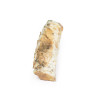Description
Clinical History
A 37-year old female presents with increasing thoracic back pain. She has a history of untreated human immunodeficiency virus (HIV) infection and pulmonary tuberculosis. History revealed ongoing low-grade fevers, chills and weight loss. Examination revealed a cachexic patient with tender thoracic vertebrae at multiple levels. Blood test showed an elevated serum calcium and erythrocyte sedimentation rate. X-ray of her spine showed lytic areas in the thoracic vertebrae. During her hospital admission, she developed urosepsis and died.
Pathology
The specimen is a portion of the patient's thoracic vertebral column that has been sawn longitudinally and mounted to display the cut surface of 7 thoracic vertebrae. In all vertebrae, there are osteolytic areas, varying from 1 to 12 mm in diameter, which contain caseous degenerative material* (mostly now lost) and are surrounded by a thin zone of dense bone. The tuberculous inflammatory process has extended into one of the intervertebral discs, and has also spread outside the vertebral bodies to form collections of caseous material beneath the anterior longitudinal ligament. This is an example of tuberculous mycobacterial osteomyelitis of the vertebral column with paravertebral extension, also known as Pott's Disease.
Further Information
Tuberculosis (TB) is a chronic pulmonary and systemic infectious disease caused by Mycobacteria tuberculosis. Transmission most commonly occurs via inhalation of aerosolized droplets of M. tuberculosis. Risk factors for contracting TB include being an inhabitant of a developing country where the disease may be endemic, immunosuppression (e.g. HIV, steroid use, anti-TNF use and diabetes), chronic lung disease (e.g. silicosis), alcoholism, and generalized malnutrition.
After initial pulmonary infection of M. tuberculosis clinical manifestation varies. In 90% of individuals with an intact immune system, they enter an asymptomatic latent infection phase. This latent TB may reactivate at any time in the patient's life. In the other 10% of patients, especially in the immunocompromised population, they develop primary disease, which is immediate active TB infection. Manifestations of primary TB include pulmonary infection symptoms (e.g. consolidation, effusion and hilar adenopathy) and extra pulmonary symptoms - lymphadenopathy, meningitis and disseminated miliary TB. Secondary tuberculosis occurs when there is reactivation of a previous latent TB infection. Around 10% of latent TB will reactivate usually during periods of weakened host immunity. Typical symptoms of reactivation are cough, hemoptysis, low grade fever, night sweats and weight loss.
Osseous infection occurs 1-3% of patients with TB infection. There is a higher incidence of developing bone disease in patients from developing countries and immunocompromised patients. The TB usually spreads hematogenously from the site of active disease. Pott's disease accounts for 40% of TB bone infections. The infection is destructive eroding vertebral discs and vertebrae leading to compression fractures, which may cause symptoms of cord or nerve root compression. Symptoms include pain at the site of disease, fevers, chills, weight loss, symptoms of compression and spinal deformities, such as kyphosis and scoliosis.
TB diagnosis is usually made with a clinical history and chest x-ray and multiple sputum cultures. Mantoux skin tuberculin test and serum interferon gamma release assay may also be used to help screen for infection. Biopsies may be taken of suspected infection site for culture to assist diagnosis.
Treatment involves prolonged courses of multiple antibiotics, which depend on the antibiotic resistance of the infecting mycobacterium species.
* Caseous degeneration or necrosis is a unique form of cell death in which the tissue maintains a cheese-like appearance.
Advantages
- Anatomically accurate and identical to real specimen
- No ethical issues - not real human body parts
- Reasonably priced
- Available within a short lead time
- Reproducible, several identical prints can be used as a classroom set
- Can be produced in different sizes to cater for the needs of the teacher
Human Cadavers
- Access to cadavers can be problematic. Many countries cannot access cadavers for cultural and religious reasons
- Cadavers cost a lot money
- High cost for establishing your own plastination suite
- Wet specimens cannot be used in uncertified labs
- Dissection of cadavers is a lot of staff time and that is a cost
- Storage of cadaver material needs special refrigeration etc. which has coast
- If you want another specimen you have to start all over again
Plastinates
- Costs
- Ethical issues
- Timeframe for plastination process
- Many countries do not allow their importation
- One of a kind
Superior 3D print results compared with conventional methods
- Vibrant color offering with 10 million colors
- UV-curable inkjet printing
- High quality 3D printing that can create products that are delicate, extremely precise and incredibly realistic
Clear Support Material
- To avoid breakage of fragile, thin, and delicate arteries, veins or vessels, a clear support material is printed on such spots. This makes the models robust and can be handled by students easily.

















